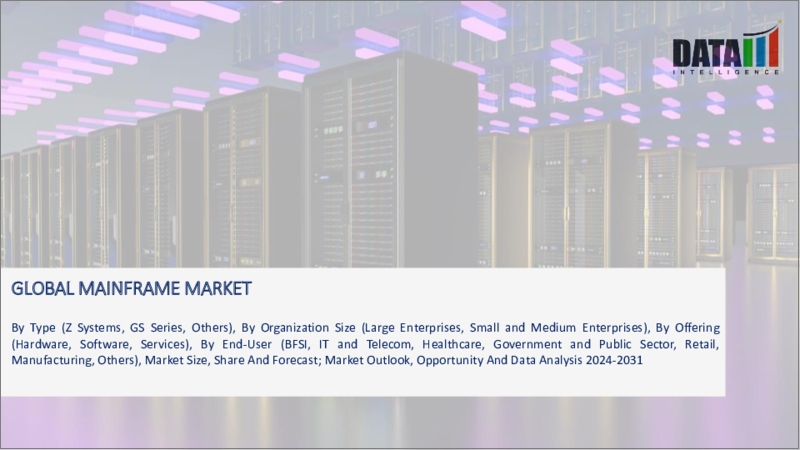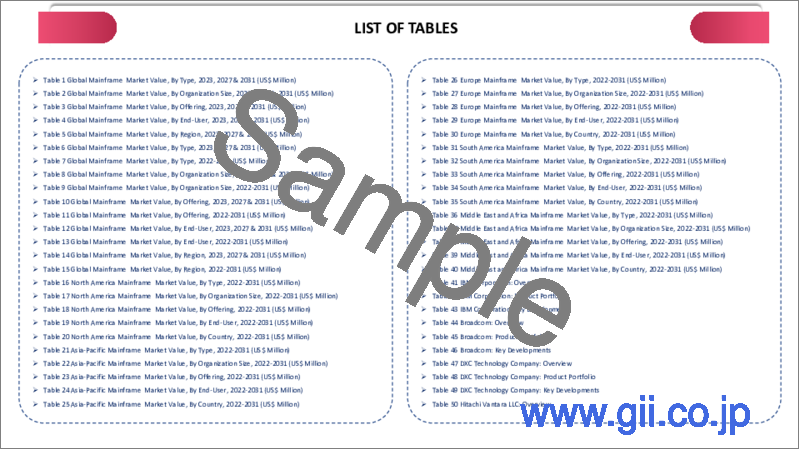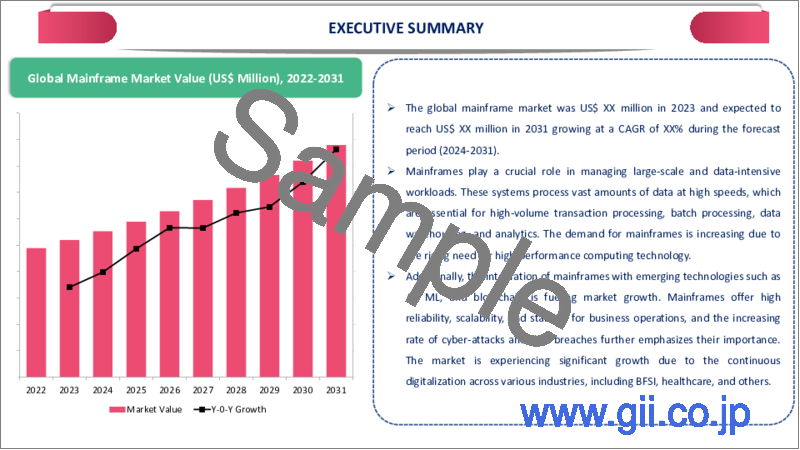|
|
市場調査レポート
商品コード
1336688
メインフレームの世界市場-2023年~2030年Global Mainframe Market - 2023-2030 |
||||||
カスタマイズ可能
適宜更新あり
|
|||||||
| メインフレームの世界市場-2023年~2030年 |
|
出版日: 2023年08月22日
発行: DataM Intelligence
ページ情報: 英文 206 Pages
納期: 即日から翌営業日
|
- 全表示
- 概要
- 目次
市場概要
世界のメインフレーム市場は、2022年に23億米ドルに達し、2023年から2030年の予測期間中にCAGR 7.2%で成長し、2030年には39億米ドルに達すると予測されています。デジタル化とモビリティの継続的なトレンドの結果として、より多くの、より多様な動向を管理しなければならないという様々な組織に対する圧力の高まりが、メインフレーム市場の成長を促進する主な理由です。
メインフレーム・ハードウェア・ソリューションは、多数のユーザーやアプリケーションが中断することなく同時に同じデータにアクセスできる機能を備えているため、トランザクション数やデータセットの増加に最適であると考えられています。ハードウェアは、予測期間中、世界のメインフレーム市場の1/4以上を占めると予測されています。ハードウェアは、巨大なワークロードを管理し、高可用性を提供し、重要なアプリケーションのデータを保護するように設計されています。
市場力学
メインフレームにおける近代化の採用の高まり
近年、メインフレームは人工知能(AI)ソフトウェア、ビッグデータ、機械学習、ブロックチェーンアプリケーションに活用されています。自然言語処理(NLP)、動画・画像処理、最適化、意思決定支援は、AIにおけるメインフレームの用途の一部です。最適化および意思決定支援ソフトウェアはメインフレーム上で実行できます。これは、サプライチェーン運営を改善し、製造スケジュールを整理し、需要を予測するために採用されるかもしれないです。
膨大な量の画像や映像データをメインフレームで処理することができ、これは物体認識や自律走行車などの用途で極めて重要です。また、膨大な量のテキストデータを処理し、自然言語処理アプリケーションを実現することができます。NLPアプリケーションは、Chabots、バーチャルアシスタント、人間の言語理解を必要とするその他のアプリケーションで活用されており、市場を牽引すると期待されています。
ハイパフォーマンス・コンピューティングへの需要の高まり
ハイパフォーマンス・コンピューティング(HPC)は、さまざまなビジネス分野に影響を与えています。さまざまな産業分野や重要なアプリケーションでは、最速のプロセッサ、最大のストレージシステム、最小のレイテンシが必要とされます。この技術は現在、金融分析、産業用アプリケーション、消費者向け製品で広く使用されています。
大規模なデータセットの拡大と高い処理能力への欲求が、メインフレームのような高性能システムの発明の主な原動力となってきました。例えば、銀行業界では近年、インターネット取引が増加しています。この地域の金融取引需要の高まりに対応するため、メインフレームシステムは銀行業界で広く使用されています。
さらに、この地域の銀行や金融サービスプロバイダーは、数百万件のクレジットカード取引を処理するためにメインフレームコンピュータを使用してきました。取引件数と不正行為の増加の結果、高性能コンピューティング・システムに対する需要が高まり、メインフレーム市場の成長に影響を与えています。
熟練専門家の不足
上級メインフレーム作業員の高齢化やその他の困難の結果、メインフレーム市場は熟練作業員の大幅な不足に直面しています。フォーチュン500企業の71%がメインフレームを使用しています。特に企業はIBM Zシステムに依存しています。業界は最も強力なプロバイダーの後ろに集まっており、IBMはその高い安全性と極めて拡張性の高いZプラットフォームへの投資を維持しています。最新のバージョンであるIBM z16は、2022年4月に導入されました。
いくつかの組織は、既存の従業員にメインフレームのスキルを教えるだけでなく、新しい人材を雇用して訓練することに意欲を示していますが、進展は遅く、全員がスピードアップするには時間がかかると思われます。メインフレームは需要の高い技術であるため、多くの高度なスキルが必要であり、現在の人材プールは比較的小規模であるため、用途が限定され、市場の成長も限定的です。
COVID-19影響分析
パンデミックによる世界・サプライチェーンへの影響は、技術生産を含む広範なビジネスに影響を与えました。メインフレームの部品メーカーや組立作業の拠点が混乱し、製品供給が妨げられました。デジタル化の進展に伴い、サイバーセキュリティはさらに差し迫った問題となっています。
機密データを頻繁に管理するメインフレームアプリケーションは、サイバー脅威から効果的に保護されているかどうかを確認するために精査されています。IBMによると、フォーチュン500社の71%が、ミッションクリティカルなトランザクションとデータ処理にメインフレームを利用しています。これらの強力な装置は必要ではあるが、新しいテクノロジーと組み合わせると限界があるため、その多くは更新が必要です。
ロシア・ウクライナ戦争の影響
地政学的危機によって引き起こされる通貨変動は、さまざまな国のメインフレームハードウェアやコンポーネントの輸入コストに影響を与え、市場の需要に影響を与える可能性があります。ロシアのウクライナ侵攻は、COVID-19パンデミックの影響から回復途上にある世界経済を脅かします。エネルギーと商品価格はここ数日で高騰しており、サプライチェーンはさらに影響を受けやすくなっています。
インフレを煽り、西欧やその他世界の成長を阻害しかねない懸念です。PC産業は近年拡大していますが、それでもサプライチェーンの混乱には極めて脆弱です。欧米の制裁を回避するため、ロシアは中国のサプライヤーに頼る可能性が高いです。レノボ、Acer、Asusなど、西側市場を目指す中国のサプライヤーは、ウクライナ情勢への対応という点で困難な立場に立たされると思われます。
目次
第1章 調査手法と調査範囲
第2章 定義と概要
第3章 エグゼクティブサマリー
第4章 市場力学
- 影響要因
- 促進要因
- メインフレームにおける近代化の採用の高まり
- 高性能コンピューティングへの需要の高まり
- 抑制要因
- 熟練した専門家の不足
- 開発ツールの複雑さ
- 機会
- 影響分析
- 促進要因
第5章 産業分析
- ポーターのファイブフォース分析
- サプライチェーン分析
- 価格分析
- 規制分析
第6章 COVID-19分析
第7章 タイプ別
- Zシステム
- GSシリーズ
- その他
第8章 組織規模別
- 大企業
- 中小企業
第9章 用途別
- トランザクション
- ERP
- 国勢調査
- その他
第10章 オファリング別
- ハードウェア
- ソフトウェア
- サービス
第11章 エンドユーザー別
- BFSI
- IT・通信
- 医療
- 政府・公共機関
- 小売業
- 製造業
- その他
第12章 地域別
- 北米
- 米国
- カナダ
- メキシコ
- 欧州
- ドイツ
- 英国
- フランス
- イタリア
- ロシア
- その他欧州
- 南米
- ブラジル
- アルゼンチン
- その他南米
- アジア太平洋
- 中国
- インド
- 日本
- オーストラリア
- その他アジア太平洋
- 中東・アフリカ
第13章 競合情勢
- 競合シナリオ
- 市況/シェア分析
- M&A分析
第14章 企業プロファイル
- IBM Corporation
- 会社概要
- 製品ポートフォリオと説明
- 財務概要
- 最近の動向
- Broadcom
- DXC Technology Company
- Hitachi Vantara LLC
- Hewlett-Packard
- Accenture
- ATOS SE
- BMC Software Inc.
- Cognizant
- Dell Inc.
第15章 付録
Market Overview
Global Mainframe Market reached US$ 2.3 billion in 2022 and is expected to reach US$ 3.9 illion by 2030, growing with a CAGR of 7.2% during the forecast period 2023-2030. The increasing pressure on various organizations to manage greater numbers and variety of transactions as a result of the continuous trend of digitization and mobility are the primary reasons driving the mainframe market's growth.
The mainframe hardware solutions are considered to be perfect for increasing the number of transactions and data sets since they have the ability to allow a large number of users and applications to access the same data at the same time without disrupting. Hardware is estimated to account for more than 1/4th of the global mainframe market during the forecast period. Hardware is designed to manage huge workloads, provide high availability and protect data for essential applications.
Market Dynamics
The Rising Adoption of Modernization in Mainframe
In recent years, mainframes have been utilized for Artificial Intelligence (AI) software, big data, machine learning and blockchain applications. Natural Language Processing (NLP), video and image processing, optimization and decision assistance are a few of the mainframe applications in AI. Optimization and decision support software can be run on mainframes. It may be employed to improve supply chain operations organize manufacturing schedules and forecast demand.
Huge amounts of imagine and video data can be processed by mainframes, which is crucial in applications like object recognition and autonomous vehicles. It is capable of processing enormous volumes of text data and enabling natural language processing applications. NLP applications are utilized in Chabots, virtual assistants and other applications requiring a human language understanding and are expected to drive the market.
The Growing Demand for High Performance Computing
High Performance Computing (HPC) has affected many different business sectors. The various industrial verticals and important applications require the fastest processors, largest storage systems and lowest latency. The technique is currently widely used in financial analytics, industrial applications and consumer products.
The expansion of large data sets and the desire for high processing power has been a primary driver of the invention of high-performance systems such as mainframes. For example, the banking industry has seen an increase in internet transactions in recent years. To fulfill the region's rising financial transaction demands, mainframe systems are widely used in the banking industry.
Furthermore, banks and financial service providers in the region have been using mainframe computers to process millions of credit card transactions. As a result of the increased number of transactions and fraudulent activities, the demand for high performance computing systems has increased, influencing the growth of the mainframe market.
Lack of Skilled Professionals
As a result of the aging of senior mainframe workers and other difficulties, the mainframe market is facing a significant lack of skilled workers. 71% of Fortune 500 organizations use mainframes. The businesses, in particular, rely on IBM Z systems. The industry has clustered behind the most powerful provider and IBM has maintained its investment in its highly secure, extremely scalable Z platform. IBM z16, the latest recent version, was introduced in April 2022.
Several organizations have expressed a willingness to teach their existing employees as well as hire and train new people in mainframe skills, but progress has been slow and it will take time to get everyone up to speed. Mainframe, being a high-demand technology, necessitates a lot of highly advanced skills and the current talent pool is relatively small, limiting its uses and limiting market growth.
COVID-19 Impact Analysis
The pandemic's impact on global supply chains impacted a wide range of businesses, including technology production. Product supply have been hampered due to disruptions in the location of mainframe component manufacturers and assembly operations. With rising digitalization, cybersecurity has become an even more pressing issue.
Mainframe applications which frequently manage sensitive data, have been scrutinized to verify that they are effectively safeguarded against cyber threats. According to IBM, 71% of the Fortune 500 rely on mainframes for mission-critical transactions and data processing. While these powerful devices are necessary, many of them require upgrading due to limits when combined with new technologies.
Russia- Ukraine War Impact
Currency fluctuations caused by a geopolitical crisis may affect the cost of imported mainframe hardware and components for diverse countries, thus influencing market demand. Russia's invasion of Ukraine threatens a global economy that is still recovering from the effects of the COVID-19 pandemic. Energy and commodity prices have soared in recent days, making the supply chain even more prone.
It is the concerns that could fuel inflation and impede growth in Western Europe and the rest of the world. The PC industry has been expanding in recent years, but it is still extremely vulnerable to supply chain disruption. To avoid Western sanctions, Russia will most likely resort to Chinese providers. Chinese suppliers with Western market ambitions, such as Lenovo, Acer and Asus, will be in a difficult position in terms of responding to the Ukraine situation.
Segment Analysis
The global mainframe market is segmented based on type organization size, application, offering, end-user and region.
The Rising Concerns of Security in BFSI Sector
BFSI is expected to hold about 1/3rd of the global mainframe market during the forecast period 2023-2030. Considering the sensitivity of financial and personal information, data security is essential in the BFSI sector. Mainframes are known for their strong security features, such as encryption, access controls and audit trails, which assist financial institutions in meeting regulatory compliance requirements.
Mainframes have a role in handling the huge amounts of data created by financial transactions and consumer interactions as the BFSI sector adopts data-driven decision-making. For example, during the Huawei Intelligent Finance Summit 2023, Lzlabs GmbH and Huawei jointly released a unique service for the upgrading of aging mainframe banking systems. The new unique solution aids banks in preserving what should be protected while also integrating effectively with other solutions.
Geographical Analysis
The Growing Opportunities in Asia-Pacific
Asia-Pacific is anticipated to have a significant growth holding around 1/4th of the global mainframe market during the forecast period 2023-2030. The region has seen economic growth and rapid digital change across a variety of industries, resulting in higher demands for mainframe computing power. Mainframes provide a dependable and scalable option as businesses develop and data requirements grow.
For example, in 2023, Hitachi Vantara, Hitachi Ltd.'s modern infrastructure and data management subsidiary, declared a new partnership with Model9, a leading in cloud data management for mainframe, to provide more access, visibility and value from essential data for enterprises which use mainframes as their key business platform. The partnership is the key for both the enterprises that use hybrid cloud environment.
Competitive Landscape
The major global players include: IBM Corporation, Broadcom, DXC Technology Company, Hitachi Vantara LLC, Hewlett-Packard, Accenture, ATOS SE, BMC Software Inc., Cognizant and Dell Inc.
Why Purchase the Report?
- To visualize the global mainframe market segmentation based on type organization size, application, offering, end-user and region, as well as understand key commercial assets and players.
- Identify commercial opportunities by analyzing trends and co-development.
- Excel data sheet with numerous data points of mainframe market-level with all segments.
- PDF report consists of a comprehensive analysis after exhaustive qualitative interviews and an in-depth study.
- Product mapping available as Excel consisting of key products of all the major players.
The global mainframe market report would provide approximately 77 tables, 81 figures and 206 pages.
Target Audience 2023
- Manufacturers/ Buyers
- Industry Investors/Investment Bankers
- Research Professionals
- Emerging Companies
Table of Contents
1. Methodology and Scope
- 1.1. Research Methodology
- 1.2. Research Objective and Scope of the Report
2. Definition and Overview
3. Executive Summary
- 3.1. Snippet by Type
- 3.2. Snippet by Organization Size
- 3.3. Snippet by Application
- 3.4. Snippet by Offering
- 3.5. Snippet by End-User
- 3.6. Snippet by Region
4. Dynamics
- 4.1. Impacting Factors
- 4.1.1. Drivers
- 4.1.1.1. The Rising Adoption of Modernization in Mainframe
- 4.1.1.2. The Growing Demand for High Performance Computing
- 4.1.2. Restraints
- 4.1.2.1. Lack of Skilled Professionals
- 4.1.2.2. Complexity in Development Tools
- 4.1.3. Opportunity
- 4.1.4. Impact Analysis
- 4.1.1. Drivers
5. Industry Analysis
- 5.1. Porter's Five Force Analysis
- 5.2. Supply Chain Analysis
- 5.3. Pricing Analysis
- 5.4. Regulatory Analysis
6. COVID-19 Analysis
- 6.1. Analysis of COVID-19
- 6.1.1. Scenario Before COVID
- 6.1.2. Scenario During COVID
- 6.1.3. Scenario Post COVID
- 6.2. Pricing Dynamics Amid COVID-19
- 6.3. Demand-Supply Spectrum
- 6.4. Government Initiatives Related to the Market During Pandemic
- 6.5. Manufacturers Strategic Initiatives
- 6.6. Conclusion
7. By Type
- 7.1. Introduction
- 7.1.1. Market Size Analysis and Y-o-Y Growth Analysis (%), By Type
- 7.1.2. Market Attractiveness Index, By Type
- 7.2. Z Systems*
- 7.2.1. Introduction
- 7.2.2. Market Size Analysis and Y-o-Y Growth Analysis (%)
- 7.3. GS Series
- 7.4. Others
8. By Organization Size
- 8.1. Introduction
- 8.1.1. Market Size Analysis and Y-o-Y Growth Analysis (%), By Organization Size
- 8.1.2. Market Attractiveness Index, By Organization Size
- 8.2. Large Enterprises*
- 8.2.1. Introduction
- 8.2.2. Market Size Analysis and Y-o-Y Growth Analysis (%)
- 8.3. Small and Medium Enterprises
9. By Application
- 9.1. Introduction
- 9.1.1. Market Size Analysis and Y-o-Y Growth Analysis (%), By Application
- 9.1.2. Market Attractiveness Index, By Application
- 9.2. Transaction*
- 9.2.1. Introduction
- 9.2.2. Market Size Analysis and Y-o-Y Growth Analysis (%)
- 9.3. ERP
- 9.4. Census Industry
- 9.5. Others
10. By Offering
- 10.1. Introduction
- 10.1.1. Market Size Analysis and Y-o-Y Growth Analysis (%), By Offering
- 10.1.2. Market Attractiveness Index, By Offering
- 10.2. Hardware*
- 10.2.1. Introduction
- 10.2.2. Market Size Analysis and Y-o-Y Growth Analysis (%)
- 10.3. Software
- 10.4. Services
11. By End-User
- 11.1. Introduction
- 11.1.1. Market Size Analysis and Y-o-Y Growth Analysis (%), By End-User
- 11.1.2. Market Attractiveness Index, By End-User
- 11.2. BFSI*
- 11.2.1. Introduction
- 11.2.2. Market Size Analysis and Y-o-Y Growth Analysis (%)
- 11.3. IT and Telecom
- 11.4. Healthcare
- 11.5. Government and Public Sector
- 11.6. Retail
- 11.7. Manufacturing
- 11.8. Others
12. By Region
- 12.1. Introduction
- 12.1.1. Market Size Analysis and Y-o-Y Growth Analysis (%), By Region
- 12.1.2. Market Attractiveness Index, By Region
- 12.2. North America
- 12.2.1. Introduction
- 12.2.2. Key Region-Specific Dynamics
- 12.2.3. Market Size Analysis and Y-o-Y Growth Analysis (%), By Type
- 12.2.4. Market Size Analysis and Y-o-Y Growth Analysis (%), By Organization Size
- 12.2.5. Market Size Analysis and Y-o-Y Growth Analysis (%), By Application
- 12.2.6. Market Size Analysis and Y-o-Y Growth Analysis (%), By Offering
- 12.2.7. Market Size Analysis and Y-o-Y Growth Analysis (%), By End-User
- 12.2.8. Market Size Analysis and Y-o-Y Growth Analysis (%), By Country
- 12.2.8.1. U.S.
- 12.2.8.2. Canada
- 12.2.8.3. Mexico
- 12.3. Europe
- 12.3.1. Introduction
- 12.3.2. Key Region-Specific Dynamics
- 12.3.3. Market Size Analysis and Y-o-Y Growth Analysis (%), By Type
- 12.3.4. Market Size Analysis and Y-o-Y Growth Analysis (%), By Organization Size
- 12.3.5. Market Size Analysis and Y-o-Y Growth Analysis (%), By Application
- 12.3.6. Market Size Analysis and Y-o-Y Growth Analysis (%), By Offering
- 12.3.7. Market Size Analysis and Y-o-Y Growth Analysis (%), By End-User
- 12.3.8. Market Size Analysis and Y-o-Y Growth Analysis (%), By Country
- 12.3.8.1. Germany
- 12.3.8.2. UK
- 12.3.8.3. France
- 12.3.8.4. Italy
- 12.3.8.5. Russia
- 12.3.8.6. Rest of Europe
- 12.4. South America
- 12.4.1. Introduction
- 12.4.2. Key Region-Specific Dynamics
- 12.4.3. Market Size Analysis and Y-o-Y Growth Analysis (%), By Type
- 12.4.4. Market Size Analysis and Y-o-Y Growth Analysis (%), By Organization Size
- 12.4.5. Market Size Analysis and Y-o-Y Growth Analysis (%), By Application
- 12.4.6. Market Size Analysis and Y-o-Y Growth Analysis (%), By Offering
- 12.4.7. Market Size Analysis and Y-o-Y Growth Analysis (%), By End-User
- 12.4.8. Market Size Analysis and Y-o-Y Growth Analysis (%), By Country
- 12.4.8.1. Brazil
- 12.4.8.2. Argentina
- 12.4.8.3. Rest of South America
- 12.5. Asia-Pacific
- 12.5.1. Introduction
- 12.5.2. Key Region-Specific Dynamics
- 12.5.3. Market Size Analysis and Y-o-Y Growth Analysis (%), By Type
- 12.5.4. Market Size Analysis and Y-o-Y Growth Analysis (%), By Organization Size
- 12.5.5. Market Size Analysis and Y-o-Y Growth Analysis (%), By Application
- 12.5.6. Market Size Analysis and Y-o-Y Growth Analysis (%), By Offering
- 12.5.7. Market Size Analysis and Y-o-Y Growth Analysis (%), By End-User
- 12.5.8. Market Size Analysis and Y-o-Y Growth Analysis (%), By Country
- 12.5.8.1. China
- 12.5.8.2. India
- 12.5.8.3. Japan
- 12.5.8.4. Australia
- 12.5.8.5. Rest of Asia-Pacific
- 12.6. Middle East and Africa
- 12.6.1. Introduction
- 12.6.2. Key Region-Specific Dynamics
- 12.6.3. Market Size Analysis and Y-o-Y Growth Analysis (%), By Type
- 12.6.4. Market Size Analysis and Y-o-Y Growth Analysis (%), By Organization Size
- 12.6.5. Market Size Analysis and Y-o-Y Growth Analysis (%), By Application
- 12.6.6. Market Size Analysis and Y-o-Y Growth Analysis (%), By Offering
- 12.6.7. Market Size Analysis and Y-o-Y Growth Analysis (%), By End-User
13. Competitive Landscape
- 13.1. Competitive Scenario
- 13.2. Market Positioning/Share Analysis
- 13.3. Mergers and Acquisitions Analysis
14. Company Profiles
- 14.1. IBM Corporation*
- 14.1.1. Company Overview
- 14.1.2. Product Portfolio and Description
- 14.1.3. Financial Overview
- 14.1.4. Recent Developments
- 14.2. Broadcom
- 14.3. DXC Technology Company
- 14.4. Hitachi Vantara LLC
- 14.5. Hewlett-Packard
- 14.6. Accenture
- 14.7. ATOS SE
- 14.8. BMC Software Inc.
- 14.9. Cognizant
- 14.10. Dell Inc.
LIST NOT EXHAUSTIVE
15. Appendix
- 15.1. About Us and Services
- 15.2. Contact Us






